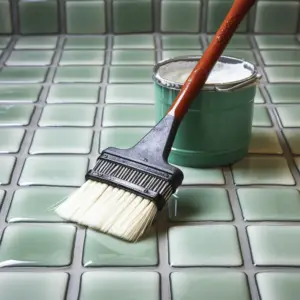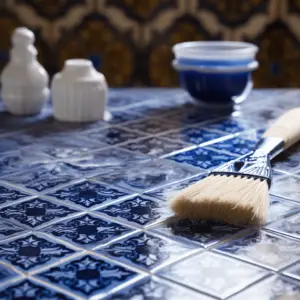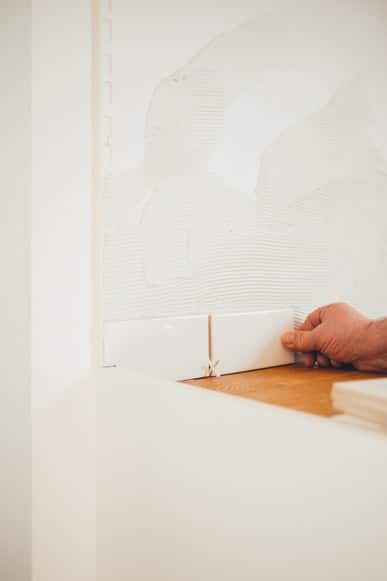It’s a rewarding and almost serene experience to do your tile and grout work. However, it’s crucial to know the specifics, such as whether you may tile and grout on the same day.
The good news is that you can often complete both aspects of the task in a single day. That isn’t always the case, though. How can you identify the difference? When you’re finished, how long do you think it’ll take to dry? This article will walk you through the procedures and explain all you need to know to correctly get the job done the first time.
Table of Contents
Can You Grout Tile the Same Day?

It is not possible to tile and grout on the same day. But, if your tile employs a rapid thin-set, you can tile and grout the next day. Otherwise, you’ll have to wait until the tiles are dry before applying grout. Unfortunately, if you don’t wait, the tiles’ integrity will be compromised, and not every tile is suitable for a quick thin-set.
How Long Should You Let Tile Sit before Grouting?
Making your tiles can be pretty fulfilling, and it can make you want to complete the project right away. Unfortunately, tile and grout cannot be placed on the same day. It takes at least twenty-four hours for the mortar to dry. Furthermore, many untrained tile setters wrongly feel that a dry edge means the entire job is done.
Unfortunately, this can lead to premature grouting. A tile with a dry edge does not necessarily imply that the tile is fully set. That is so because the airflow under a tile differs significantly from the airflow around the edges; thus, the edges tend to dry more quickly. This does not imply that you should begin grouting immediately.
For thin-set mortar, it’s usually recommended to wait at least 24 to 48 hours. It will take longer if you’re using a non-thin-set, but it will be worth the wait. Always read the instructions on your mortar carefully and allow enough time for it to set up.
What Happens to Grout If You Apply It Too Soon
It is not a good idea to grout the same day as you tile. Cutting corners, particularly when it comes to tiling, will not save you money in the long term. To attach to the wall, the mortar must cure completely.
When you don’t allow the mortar to set correctly, you’ll wind up with tiles that aren’t quite as firmly attached to the surface underneath as they should be.
You may not notice any issues right away, but those tiles will eventually fall out, and you’ll have to redo the entire region because you never allowed it to cure completely. It’s a waste of time and money to do so.
Similarly, grouting too quickly will affect the grout. Your mortar’s water has to go somewhere. The only place it can go once it’s sealed within is into the grout. This has an impact on the consistency, dry time, and overall working life of your grout.
If you use the gun to grout sooner, you’re more likely to witness cracking, shrinkage, and other grout issues. In a few months, you might have to redo the entire job. Save time and money by avoiding such mistakes. Do it well the first time so you can sit back, relax, and admire your lovely work for years to come.
How Long Does It Take Grout to Dry
When it comes to tiling, patience is essential. For standard grout, you’ll have to wait at least a day, but this isn’t always the case. Notably, depending on the climate patterns, it may take longer.
The moisture level in the air will affect the project if you reside in a region with high humidity or if it is damp outside when you set and dry your grout. The simple explanation is that the more water in the air, the more difficult it is for water to evaporate.
Instructions will always be included in your grout. However, it usually is best to wait for 3 to 7 days before exposing grout to further moisture. A week may seem like a long time, but it will be worth it when you don’t have broken grout falling out of the crevices between your tiles because you were impatient.
Once cured, cement-based grouts frequently require sealing. On the other hand, an epoxy-based grout usually doesn’t require the extra step and is waterproof on its own. You can save some of your time by using grout that doesn’t need to be sealed.
How Do You Get Grout Off of Tile After It Dries
You may have cleaned the excess off as you worked if you planned ahead during the tile and grout process. A little grout haze, however, cannot always be avoided.
Use a wooden paint stick or an abrasive nylon sponge to remove the excess grout from your tiles. A sugar solution dissolved in warm water can also be helpful.
Stir approximately a cup of sugar into six glasses of hot water until it dissolves. Over the grout spots, pour your solution. The sugar crystals help scrape away the excess without causing damage.
Will Vinegar Remove Grout Haze

For porcelain tile, a 1:4 ratio of white vinegar and water can remove grout haze. However, it is critical to note that vinegar should not be used on stone or slate tiles.
The tiles will be harmed if you do so. Yes, vinegar can be used to clear the excess, but only on certain types of tile.
Final Take
Tile and grout work demands patience and care. It is not possible to grout tile on the same day. However, whether you choose tiles that perform well with a rapid thin-set or not will influence how soon you can grout.
Jumping the gun will mean you have to redo the task later, so it’s preferable to follow the recommendations carefully.


